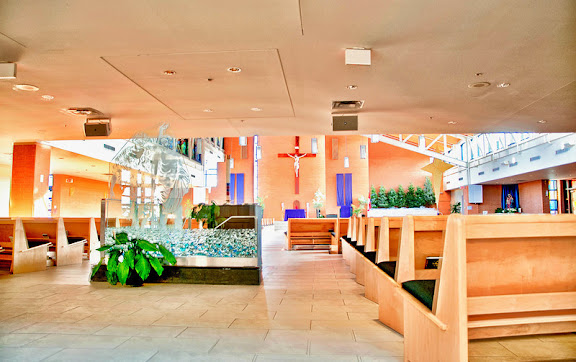In 1964, Baptism, Marriage, Confirmation,
First Communion and Death records of each parish in the Archdiocese of Toronto
were microfilmed so that copies of these records could be retained by the Chancery. The copies were updated several times between 1964 and 1983. In order to ensure that updates would
occur regularly, the Archives began a five year cyclical microfilm program in 1993. The
Parish Sacramental Records Microfilm Program ensures that the Archdiocese of
Toronto is maintaining a backup copy of our most vital records. You can find
out more about the program here.
 |
| Photograph of 1863 Baptisms in the original 1850-1901 Baptism and Marriage Register of St. John Chrysostom Parish, Newmarket
Accession 2010-009
ARCAT Staff Photo
|
 |
Photograph of the microfilm copy created in 1964 of the same page of 1863 Baptisms from the 1850-1901 Baptism and Marriage Register of St. John Chrysostom Parish, Newmarket
ARCAT Staff Photo
|
Why Microfilm?
We are often asked why we still use
microfilm technology for this program with the plethora of digital solutions
available. The answers are simple: digital records are even more fragile than the
original handwritten registers, and technology is constantly changing.
One analogy I use to illustrate digital fragility is this: imagine taking a pen with a sharp tip and deliberately slashing across a page of a paper sacramental register. You may have marred a letter or two, but overall the information on that page and in the rest of the book will still be completely legible. If you did the same thing to a strip of microfilm, you may have to repair the affected area and you will likely have trouble making out a word or two on the page, but again, overall the information is still intact. Now, imagine slashing a disc or other electronic storage media with a sharp object. You may have gotten lucky and only corrupted one record or one image of a whole page; but, the more likely scenario is that you have rendered the entirety of the information stored on that media inaccessible or indecipherable.
One analogy I use to illustrate digital fragility is this: imagine taking a pen with a sharp tip and deliberately slashing across a page of a paper sacramental register. You may have marred a letter or two, but overall the information on that page and in the rest of the book will still be completely legible. If you did the same thing to a strip of microfilm, you may have to repair the affected area and you will likely have trouble making out a word or two on the page, but again, overall the information is still intact. Now, imagine slashing a disc or other electronic storage media with a sharp object. You may have gotten lucky and only corrupted one record or one image of a whole page; but, the more likely scenario is that you have rendered the entirety of the information stored on that media inaccessible or indecipherable.
Furthermore, accessing the
records becomes increasingly complicated as you upgrade
technologies. So many things have to work in order to view electronic records, with the most basic need being electricity; in a power outage, microfilm could, if necessary, be read with a light source and a magnifying glass. The equipment and programs
used to create, store, and use digital material change very rapidly and older
technologies quickly become obsolete. To save information long term, it needs to be constantly migrated to new digital formats and new hardware. So, if you were to scan a baptism record from today, there is no guarantee that
the information from the digital copy will be accessible by the time the child
is requesting a copy for their First Communion, let alone their Confirmation or
their Marriage perhaps 20 years from now. Sometimes, as in the case of
microfilm technology, the simpler solution is the longest lasting.
As with most things in archives
(and life for that matter!), context is key. The purpose for creating the copy
needs to be the first thing you consider when deciding the method you will use
for your program or project. While electronic copies of the records do indeed
facilitate the sharing of information for day-to-day administrative purposes, they are not the best solution for long-term storage. The primary
purpose of our Parish Sacramental Records Microfilm Program is to create a
backup copy of our organization's most vital records, so the copy needs to be
considered as stable and viable in the long-term as the original. Microfilm will easily last as long as the original
sacramental registers, and it is even harder to destroy than paper.
Another benefit of
microfilm is that you are not limited to that format alone once the process is
complete. Digitizing microfilm is a fairly simple process
with the right scanning equipment. There are dioceses running similar
programs who have chosen to have their vendor create both a microfilm copy of
the sacramental records as the vital records backup and digital images for
simplicity of access at the same time.
One of the most satisfying outcomes
of this program is that the Archives staff are able to use the microfilm copies
to facilitate searches for sacramental records when individuals don't know
where their sacraments took place. For more information on how we conduct searches
for a sacramental record, please see here. Our reference statistics
consistently show that sacramental records searches make up almost 1/3 of our
total reference requests and nearly 50% of our external reference requests.
 |
Gillian Hearns, Director of Archives and Privacy Officer, viewing the microfilm.
|















